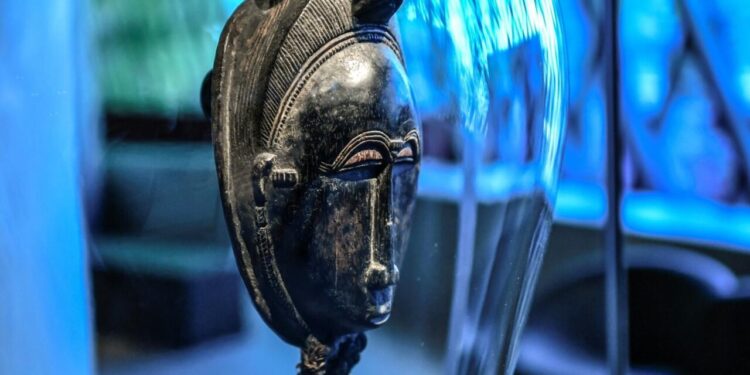In a significant gesture of reconciliation, France has expressed its support for the return of a historic colonial-era artifact, known as the “talking drum,” to Côte d’Ivoire. The move comes amidst ongoing discussions about the restitution of cultural treasures taken during the colonial period, reflecting a growing recognition of the need to address the legacies of colonialism. This particular drum, which holds deep cultural and historical significance for the Ivorian people, serves as a symbol of communication and tradition. As France acknowledges its role in the complex narrative of colonial artifacts, the potential return of the talking drum underscores a broader dialogue about heritage, identity, and the responsibilities of former colonial powers. This article explores the implications of this development and its significance within the context of France’s evolving relationship with its former colonies.
France Advocates for Return of Colonial-Era Talking Drum to Ivory Coast
In a significant move towards reconciling historical injustices, France has expressed its support for the repatriation of a cherished cultural artifact, the colonial-era talking drum, originally taken from Ivory Coast. This instrument, known for its ability to convey messages over long distances through intricate rhythms, holds deep cultural significance within Ivorian communities. The push for its return underscores a growing sentiment in France and across former colonial powers to address legacies of colonialism by returning artifacts not only as a means of restitution but also as a symbol of respect for the cultural heritage of nations previously subjected to colonial rule.
The decision to advocate for the return of the talking drum aligns with broader efforts by France to restore various artifacts taken during its colonial past. This initiative is framed within a context of renewed discussions about cultural restitution, highlighting several key points:
- Historical Reconciliation: Acknowledges the deep-rooted impact of colonialism.
- Cultural Identity: Empowers Ivorian communities by restoring their cultural symbols.
- International Relations: Improves diplomatic ties between France and Ivory Coast.
The discussions surrounding the talking drum are part of a larger dialogue on the return of cultural heritage across borders. France’s advocacy may pave the way for further negotiations regarding other significant artifacts in its possession. As part of this movement, cultural representatives from both nations are set to engage in collaborative discussions aimed at not only returning the drum but also fostering mutual understanding and appreciation of each other’s cultural milestones.
Cultural Significance and Historical Context of the Talking Drum
The talking drum, known for its unique ability to mimic human speech, holds profound cultural significance in West African communities, particularly in Côte d’Ivoire. Traditionally, it has served as more than a musical instrument; it is a vital tool for communication, storytelling, and conveying messages across vast distances. This drum was often used in ceremonies, celebrations, and funerals, embodying a rich tapestry of history and social context. Its rhythms resonate deeply within the communities, serving to relay news, summon people for gatherings, and express collective identity and heritage.
Historically, the talking drum is deeply intertwined with the oral traditions of the region, where storytelling is a cornerstone of cultural preservation. The instrument symbolizes resilience and continuity, particularly in the face of colonial challenges. The repatriation efforts by nations such as France not only acknowledge the historical injustices of colonialism but also reestablish the cultural dialogue that the talking drum represents. This initiative can be seen as a step towards restoring lost heritage, fostering understanding, and celebrating the vibrant narratives embedded within the rhythms of this iconic instrument.
Building Bridges: Recommendations for Collaborative Cultural Repatriation Efforts
As nations worldwide continue to grapple with the legacy of colonialism, collaborative cultural repatriation efforts are essential for fostering understanding and healing. A multi-faceted approach should be embraced by countries and cultural institutions to facilitate these exchanges. Key strategies include:
- Open Dialogue: Initiating conversations between the countries of origin and holders of cultural artifacts can lead to constructive partnerships.
- Cultural Education: Implementing educational programs aimed at both local communities and the international audience can promote awareness of cultural significance.
- Legal Frameworks: Establishing clear, legally binding agreements can aid in the transparent return of items to their rightful places.
Furthermore, it is vital to recognize the roles of technology and innovation in these processes. Digital archiving and virtual tours can help engage wider audiences while preserving heritage. Consideration should also be given to the economic impacts on both sides of the repatriation dialogue. A potential model for discussion could be highlighted in the table below:
| Element | Impact on Source Country | Impact on Hosting Institution |
|---|---|---|
| Cultural Preservation | Strengthened national identity | Enhanced public interest |
| Economic Opportunities | Tourism potential | Increased donations and patronage |
| Social Cohesion | Community engagement | Improved community relations |
Future Outlook
In conclusion, France’s decision to support the return of the historic talking drum to Côte d’Ivoire marks a significant step toward addressing the colonial legacy that has long impacted relationships between former colonizers and their territories. As cultural heritage gains recognition as a vital component of national identity, this move not only symbolizes France’s acknowledgment of its past but also underscores the importance of restoring artifacts to their native lands. With the talking drum set to embark on its long-awaited return, both countries stand poised to engage in meaningful dialogue about reconciliation and cultural respect, fostering a renewed understanding rooted in history and collaboration. As this story unfolds, it may pave the way for similar initiatives, bringing to light the enduring value of cultural artifacts in healing and bridging divides between nations.














